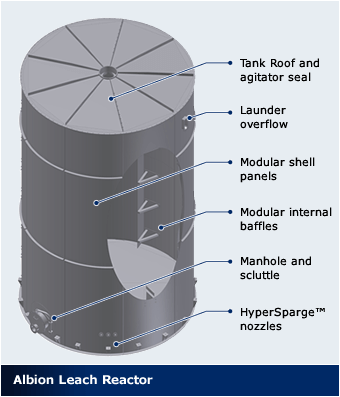Each of these Gold Refractory Process aim at the oxidation of sulphide minerals and utilizes a combination of fine grinding (3 to 9 microns) under mild conditions.
Activox is a low temperature (90-100°C), low pressure (1000kPa) process.
Albion is a low temperature (90-95°C), atmospheric pressure process.
Albion’s reactor is not “just a tank”. It is specially design to optimize oxygen injection for best oxidation.
Conventional pressure oxidation (POX) operates at temperatures exceeding 200ºC with over-pressures of 2,200 kPa or more. Reaction rates are very fast.
We believe Albion is the more cost effective solution for refractory gold applications/feeds, however we do not want to be drawn into the shortcoming of other technologies.
Nonetheless, a few high-level differences:
Albion is commercially proven, Activox is not. We understand that there was one demonstration plant built for Activox for a nickel application. This has now been shut down by Norilsk
· Albion operates at atmospheric pressure + static head (10m of slurry provides a significant static pressure) and ~95 °C. Activox operates at 1000 kPa and ~110 °C.
· Albion reactors are stirred tanks, Activox requires a pressure vessel (autoclave) and has all the associated issues around safety, operation, expense and potentially long ramp up period. The latter point is important when you come to look at NPV for the project.
· Albion is thermally self-regulating because it is open to atmosphere, whereas Activox requires active cooling which is typically a combination of flash vessels and quench water injection.
· Due to the higher partial pressure of oxygen in Activox it requires less time to achieve a given SOx than Albion (this is Activox’s main advantage). A corollary is that Activox has a smaller footprint than Albion.
· Albion for gold is generally run at neutral pH (pH 4-6), which produces zero elemental sulphur (a cyanicide) and zero jarosite (a passivating agent and unstable residue) and also allows use of less expensive materials of construction. Activox operates in a very highly acidic environment which causes both elemental sulphur and jarosite formation, and the autoclave requires brick lining or similar.
· The acid generated in Activox needs to be neutralized ahead of CIL (assuming a gold application here), which is an addition to the capital and operating cost of the Activox plant. Also the acidic bleed liquors not advancing to CIL will also need neutralisation. Often the capital and operating cost for this step is neglected when comparing options. Conversely the Albion Process for gold includes the neutralization of this acid and so this is automatically included in any quoted capex and opex.
· Albion will likely achieve a higher operating availability than Activox due the more benign operating conditions and simpler equipment.
So to sum up, if you want a robust, simple to operate and low capex/opex solution in order to maximize the margin you make on each ounce of bullion, Albion provides this.

